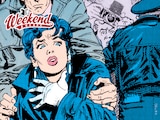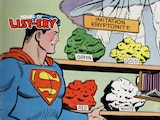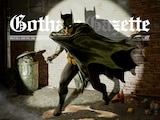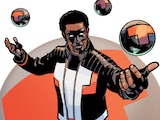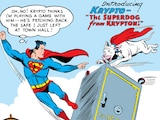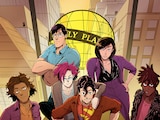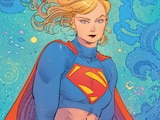It’s enough to make other DC characters become Green…with envy.
Poison Ivy, the monthly comic series about the scientist, ecoterrorist and sometime Bat-villain by G. Willow Wilson and Marcio Takara, reached an impressive new milestone this week with the release of its 30th issue. It’s an impressive feat for a horror-tinged series that frequently reminds us just how disturbing Pamela Isley’s unique abilities can be.
Then again, perhaps it’s not so surprising since as anyone who’s read Poison Ivy can tell you—it’s really good. Winner of the GLAAD Media Award for Outstanding Comic in 2022 and maintaining a consistent creative team that has only gotten better with each new storyline, Poison Ivy is more relevant than ever—a fact that became uncomfortably clear as we spoke with Wilson about the book’s success recently in Los Angeles. With the smoke from the city’s recent fires as the backdrop, our discussion touched on the role environmental concern likely plays in the book’s success, what sort of balancing act it requires to write an ecoterrorist and whether Pamela’s anger or empathy is ultimately likely to win out.

When the Poison Ivy series began back in 2022, did you have any idea it would run for thirty issues? Did you have story ideas for that long of a run?
I had no idea that we’d still be putting out monthly Poison Ivy at this point, but I’m delighted about it.
I think with a character like this who has such a rich history, and such a long history in the DC Universe, there are so many different storylines that you could pick up. I feel like we’ve got material for years, but at the same time, the idea that she’s been able to hold her own ongoing series for this long is pretty remarkable, especially considering that this grew out of an eight-page short story that became a six-issue miniseries. It’s not often that you get an ongoing series order out of something that small.
It does feel like a character like Poison Ivy getting that long of a series is very rare. It’s impressive and a real milestone. So, what’s it like writing an ecoterrorist? There aren’t too many characters in the world of superhero comics that fit that definition.
It’s true. I have found it to be a really unique and rewarding challenge because she’s a villain—she does things that are horrifying to the average person. She’s not a character who has a mandate not to kill people. In fact, she kills people all the time, but she’s doing it for reasons we understand. She’s doing it out of love of the earth, a desire to preserve the natural environment and to combat climate change. So, we agree with her motives, just not with her methods.
It’s a really interesting line to walk because you don’t want to be seen to be glorifying the murder of innocent people, but at the same time, she’s got an urgency that I think a lot of us have. The rest of us are just kind of recycling and changing out our lightbulbs and she’s like, “No, I’m going to take direct action.”
It’s an interesting balance.

Why do you think Pamela resonates with so many people? Has your understanding of her popularity changed since you started writing the series?
I think she’s very much a character of the current moment despite the fact that she’s almost sixty years old now. I think that urgency she feels about time running out to save the planet is shared by a lot of people, particularly young people. I think that’s what’s given Pamela her star power at this moment in time.
With any comic book character or series, 80% of popularity is timing. Are you capturing the zeitgeist? You can do the same book five years earlier or five years later and not have the same response. When you get a big response, it’s because it’s the right character at the right time. I think at this moment in time, with so people’s lives being completely changed and altered in terrible ways due to climate change, this is an issue that people are thinking about on a daily basis.
It's interesting hearing you answer that question considering we’re in Los Angeles right now.
I was going to say! You guys have direct experience with this.
For most of the series, you’ve been working with artist Marcio Takara. What’s it like collaborating with the same artist on the same book for so long? Has your collaboration evolved in any ways?
The fun thing about working long-term on the same series with the same team is that you develop a sort of shorthand. There’s a culture that evolves that’s specific to that book. At the beginning, I was writing panel descriptions that were really long and intricate, but now we’ve been doing this for so long that everything has kind of a pattern. So much of the world is understood between us because we’ve all built it together and that’s really special. Things definitely change once you have that unique working relationship—that distinct environment that everyone can navigate around, and everybody knows what things look like and where things go. That feels great.

I feel very fortunate to work not just with Marcio, who’s just done an unbelievably stunning job on this book, making it look both beautiful and disgusting in equal measure, but Arif Prianto, the colorist, and Hassan Otsmane-Elhaou, the letterer, who have done really stunning things. When you have a really excellent letterer, it changes the whole tenor of the book—the beats are very clean and things land in the right way. So, Hassan’s done an incredible job. Jessica Fong, our series cover artist—every single month I feel like, “Oh my gosh, you can frame this and put this on a wall.”
I think the whole team really clicked and really loves this book, and that doesn’t happen all the time.
I look at the world today and I think Pamela Isley would have a lot of reasons to be angry. What do you think ultimately wins out? Her anger towards humans or her empathy towards them? It feels like it may be just hanging by a thread.
Oh yeah, that’s the ten-million-dollar question, and every time we think we’ve got it answered, something happens to change that answer. At the end of the day, I think her primary loyalty is towards the Green, towards plant life on this planet. And yet, she’s not so removed from ordinary human experience that she can’t love and laugh. She’s had this long-running romantic relationship with Harley Quinn, and she doesn’t want to envision a world without Harley in it. So, there are things keeping her human, and that’s the tension of the book.
So, there isn’t an answer. We keep going back and forth. But that’s the primary question.
Let’s just hope Pamela and Harleen never have a bad breakup, though. I would worry.
Yes! Everybody should worry if that happens!
Poison Ivy #30 by G. Willow Wilson, Marcio Takara and Arif Prianto is now available in print and as a digital comic book. Get caught up with the series on DC UNIVERSE INFINITE.


